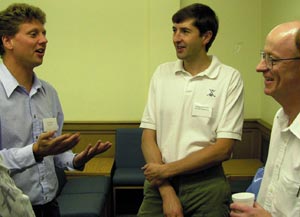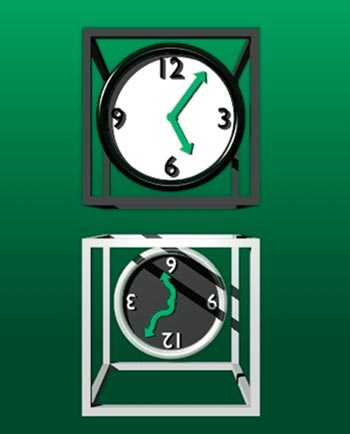Experimentalists and theorists from around the world recently gathered at Indiana University to exchange the latest findings from their experiments in the search for the violation of Lorentz symmetry.
Efforts to test Lorentz symmetry at ever-increasing sensitivities have opened up new perspectives in theoretical and experimental physics. While high-energy accelerators have traditionally been designed to probe fundamental particles at ever-smaller microscopic scales, it has been known for some time that data from many such experiments could contain information about weak Lorentz-violating background fields that exist in space on scales the size of the solar system and greater. Among the basic signals being sought are sidereal variations arising due to the rotation of the Earth relative to the fixed background stars. Measurements of these effects at CERN and similar facilities can potentially also be confirmed in other experiments, such as those involving atomic clocks, masers, torsion pendulums, optical and microwave cavities, astronomical polarization data and Penning traps, to name some examples. The triennial Meeting on Lorentz and CPT Symmetry (CPT ’04), held at Indiana University on 4-7 August 2004, provided a forum for researchers in the field to compare results and new ideas.

Lorentz symmetry, the feature of nature that says experimental results are independent of the orientation or the boost velocity of the laboratory through space, has survived a century of tests since Albert Einstein introduced the special theory of relativity. CPT, the combination of charge reversal (C), parity inversion (P) and time reversal (T), is a closely related symmetry of nature that also appears to be exact. The general theory of Lorentz and CPT violation, known as the Standard Model Extension (SME), was developed by Alan Kostelecky and collaborators at Indiana University as part of the effort to unify the theories of quantum mechanics and gravity by investigating the full range of possible violations of Lorentz and CPT symmetries. The violations appear in the SME as minuscule coefficients, which are estimated to be observable in experiments that are sensitive at the Planck scale, where quantum mechanics and gravitation are merged. Numerous experiments are able to reach these sensitivity levels and have explored the coefficient space of the SME for almost 10 years.

The opening session of CPT ’04 featured theorist Yoichiro Nambu from Chicago University and experimentalist Ron Walsworth from Harvard. Nambu outlined several interesting and counterintuitive features of physics that could be observed in a Lorentz-violating world. In efforts to study such a world, many experiments employ, or plan to employ, rotating turntables and highly controlled laboratory environments. Walsworth spoke about the idea of a dedicated facility to provide these technical services. He also discussed an experiment using co-located helium and xenon masers to place the first bounds on 11 combinations of SME coefficients for the neutron.
Tests with neutrinos and photons
Carlos Peña-Garay of the Institute for Advanced Study at Princeton presented the theoretical arguments for massive neutrinos based on observations from solar neutrinos, atmospheric neutrinos and the KamLAND experiment in Japan. The SME offers a general framework for Lorentz and CPT violation in the neutrino sector, and in particular a general analysis of neutrino oscillations exists. The full range of effects involves dozens of coefficients, but a simple two-coefficient model with no neutrino masses has been devised by Kostelecky and Matt Mewes at Indiana University. Mark Messier of the SuperKamiokande collaboration showed in his talk that this rudimentary model, dubbed the “bicycle” model, fits the atmospheric neutrino data from SuperKamiokande just as well as the fit with models involving neutrino mass differences. The MINOS experiment, due to become fully operational in December, may be able to resolve sidereal effects as predicted by the SME. This experiment will take data in the Soudan mine in northern Minnesota from a neutrino beam originating at Fermilab near Chicago.
Data from the Liquid Scintillating Neutrino Device (LSND) experiment at Los Alamos can be interpreted as showing that there is a 0.26% probability that a muon antineutrino will decay into an electron antineutrino over a distance of about 30 m. Rex Tayloe from the LSND collaboration presented a discussion of efforts that are under way to investigate whether the SME coefficients can successfully account for both the LSND data and the atmospheric and solar-neutrino data.
The SME shows that 19 independent components control Lorentz-violating effects on photons. The absence of any observed frequency dependence in the polarization of light from distant quasars places a bound of parts in 1032 on several of these coefficients. Birefringence observations cannot access the remaining ones, but modern Michelson-Morley and Kennedy-Thorndike experiments are doing so using cavity oscillators. Michael Tobar of Western Australia presented the sharpest measurements to date on several combinations of the coefficients, obtained using microwave oscillators. He hopes to improve on them soon with the aid of a rotating platform. Achim Peters, from Humboldt University in Berlin, reported on another experiment using optical resonators created from a single sapphire crystal. He outlined various plans for improving the sensitivity, including better cryogenics and a turntable mount to aid in searching for sidereal variations.

Claus Lämmerzahl of Bremen discussed theoretical approaches to Lorentz violation in the context of electromagnetism. His approach modifies the field equations without requiring a Lagrangian, and the resulting effects include charge non-conservation. An analysis accounting for the changes in length of an optical cavity as it interacts with the SME background was presented by Holger Müller of Stanford University. The approach highlights the interconnectivity of the photon sector in the SME with the fermion sector involving atoms and molecules.
Lämmerzahl also described the OPTIS project, a mission of the European Space Agency, which plans to place optical resonators and masers on a dedicated satellite. The mission will offer a number of advantages over ground-based tests of Lorentz symmetry. The status of programmes that are funded through NASA for other space tests was outlined by Joel Nissen of Stanford. He pointed out that the Superconducting Microwave Oscillator (SUMO) mission could be adapted to fly independently of the International Space Station.
Tests in atomic physics
Various Lorentz tests have been done or are planned in atomic systems, and include three experiments at CERN that involve antiprotons. Ryugo Hayano of the ASACUSA collaboration reported on efforts to study the spectrum of antiprotonic helium. Another test involves comparison of the antihydrogen spectrum with that of conventional hydrogen. Alban Kellerbauer of the ATHENA collaboration reported on the status of the effort to create, cool and trap antihydrogen. Together with the ATRAP antihydrogen collaboration, ATHENA and ASACUSA utilize CERN’s Antiproton Decelerator facility to supply antiprotons. In terms of the SME, comparison of the hyperfine levels of the atomic spectra could test CPT symmetry for the proton. Whereas searches for sidereal variations using only one species of atom access complicated combinations of SME coefficients, the test involving hydrogen atoms and anti-atoms is clean and would be difficult to duplicate in other experiments.
Penning traps are other devices that allow comparisons of properties of particles and their corresponding antiparticles. Brian Odom reported on the progress of Gerald Gabrielse’s group at Harvard working on a new measurement of g-2 for the electron and positron. It is expected that the researchers will be able to improve significantly on existing resolutions.
Atomic clocks operating on transitions involving a change in the spin state have the potential to test Lorentz coefficients in the SME with great precision. Mike Romalis from Princeton discussed the status of his potassium-helium comagnetometer, involving a mixture of these two atoms in a single bulb. The experiment, which has the potential to achieve record sensitivities, is currently taking data. Atomic clocks have been planned to fly on the International Space Station or other space platforms, providing increased speeds and rotation rates and hence improved sensitivities for tests of Lorentz symmetry. Kurt Gibble of Penn State reviewed the status of his two-arm rubidium clock, which may eventually be used to perform Lorentz tests in space.
Blayne Heckel and Eric Adelberger of the “Eöt-Wash” torsion pendulum group at the University of Washington in Seattle discussed progress in several experiments. One type of pendulum employs a bob with a net electronic spin but no net magnetic field, and oscillates torsionally from a thin thread. The group is trying to eliminate systematic effects possibly due to swing, bounce and wobble of the thread in their most recent version. Preliminary results show that they already have significant improvements in sensitivity to Lorentz-violation coefficients in the electron sector.
Violations in theory
The SME has enjoyed broad interest because it encompasses Lorentz-violation experiments from all areas of physics. It is a step in the quest to produce a single theory that unites the quantum world with the theory of gravitation. In the absence of a fundamental theory that achieves this goal, the SME provides a full set of possible Lorentz- and CPT-violating effects that could reasonably occur in the low-energy limit of such a theory.
At the fundamental level, theorists are currently considering various ideas, including string theory and several forms of quantum gravity. Daniel Sudarsky of the National University of Mexico (UNAM) gave a review of some approaches, particularly loop quantum gravity. Ralf Lehnert of Vanderbilt University discussed how Lorentz violation can be associated with space-time-varying couplings in a scenario with a cosmological scalar field. Lorentz tests in atomic experiments have a variety of generic features, and Robert Bluhm of Colby College gave a comprehensive overview of these and the related theory. Some of these features are also common in Lorentz tests in other experimental sectors.
Should Lorentz violation be found soon, it would be a fitting time to build on the foundations laid by Einstein a century ago.
The past 10 years have seen a first generation of Lorentz experiments probing SME coefficients in the theoretical context of a flat space-time. A second generation of tests has the potential to probe the SME with gravity. Kostelecky presented some of the myriad of features of the SME in a curved space-time. Particles with spin are incorporated into the space-time structure using the “vierbein” formalism, rather like a mathematical four-legged spider placed in a smoothly varying manner at each point in the manifold. The coefficients for Lorentz violation acquire additional dependence on features such as the space-time metric and on associated properties like torsion and curvature.
The plethora of experiments aimed at identifying violations of Lorentz symmetry bear testimony to the continued relevance of Einstein’s achievements. The ever-increasing sensitivity to SME coefficients continues to strengthen this legacy. Remarkably, much of the SME coefficient space is still unexplored. Should Lorentz violation be found soon, it would be a fitting time to build on the foundations laid by Einstein a century ago.







